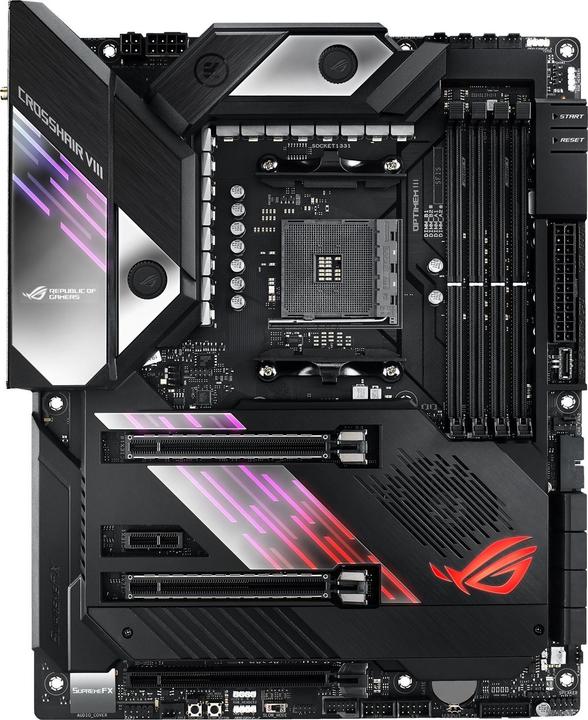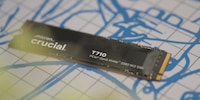

Crucial P5: The SSD for gamers
With the P5, Crucial launches its first SSD that approaches the performance limits of four PCI Express 3.0 lanes. PCIe 3.0? Exactly, Crucial is still using the old standard.
PCIe 4.0 was introduced for the desktop in 2019 with the Ryzen 3000 series. Nevertheless, Crucial is still relying on PCIe 3.0 in 2020. One reason for this is probably that the manufacturer only jumped on the NVMe SSD bandwagon in October 2018 and is therefore simply not yet at that stage of development. Crucial itself says that the market for PCIe 4.0 is still too small.
The P5
The Crucial P5 SSD is the Micron subsidiary's most powerful model to date and is said to read data at up to 3400 MB/s and write data at up to 3000 MB/s. The P5 series comes in the M.2-2280 form factor and is available with 250 GB, 500 GB, 1 TB or 2 TB of storage space. However, the 250 GB version writes data at 1400 MB/s, which is significantly slower than its siblings. In comparison with WD and Samsung, however, Crucial is in a good position: the two competitors only offer the full speed of their NVMe SSDs from a storage capacity of 1 TB. I used the 1 TB model for the test.

Micron triple-level cell (TLC) memory chips and a self-developed controller with hardware encryption are used. The high write speed applies to a dynamic pseudo-SLC cache, which only writes one bit per cell instead of three.
The P5 SSDs come with a five-year manufacturer's warranty. The average operating time (Mean Time To Failure, MTTF) is 1.8 million hours. Depending on the capacity, Crucial specifies a service life of 150 to 1200 terabytes written (TBW).
In terms of IOPS - Input/Output Operations Per Second - Crucial specifies 390,000 for the 1 TB model at 4 KB random read and 500,000 at 4 KB random write.
Crucial offers the Storage Executive software for the P5. This can be used to monitor the SSD, download the latest firmware, customise the encryption and activate the Momentum Cache function. This is a software driver that dynamically utilises unused system resources to improve the burst performance of the SSD. I only activate this function for a comparison in the ATTO Disk Benchmark and Anvil's Storage Utilities. Otherwise, I leave the function deactivated.
If you want to know more about how SSDs work, I recommend the following article.
Test method and set-up
To monitor the temperature of the SSDs, I use CristalDisk Info. The tool also gives me information on the health of the drives, the interface and the transfer mode. If you are interested in the influence of temperature on the speed of an SSD, I recommend the following article.
The ATTO Disk Benchmark uses uncompressed data. It tests the read and write performance of various transfer sizes from 512 B to 64 MB. The read and write performance data of many manufacturers is based on this test methodology: it delivers better results as raw data can be read and written quickly. In everyday life, however, SSDs also have to deal with compressed data, which is why I run additional benchmarks.
The benchmark from Anvil's Storage Utilities not only shows the read and write speeds, but also information on IOPS and response times. I can also determine the proportion of compressed and uncompressed data in the benchmark. I set the proportion of compressed data to 46 per cent. I leave the remaining settings at default.
The PCMark 8 storage benchmark is based on an actual scenario. The PCMark 8 storage test simulates work steps of various applications from the Adobe Creative Suite, Microsoft Office and games. It records the storage activity and generates a benchmark score based on the stored hard drive activity.
In addition to the three benchmarks, I measure the loading time for "Final Fantasy XV", "Rise of the Tomb Raider" and "Resident Evil 2 Remake". Last but not least, I install "CS: GO" and see how long the installation takes.
I run the test on our DimasTech Easy V3.0 benchtable with the following components:
I run the tests three times each and take the best result. I use the WD Black SN750, which I have already tested and which is also based on PCIe 3.0, as a comparison value.
ATTO Disk Benchmark
The P5 only develops its full read and write speed from a file size of around 512 KB. The write rate is around 2.8 GB/s and the read rate is 3 GB/s. I did not achieve the 3 GB/s or 3.4 GB/s promised by the manufacturer in the benchmark. Compared to the SN750, the P5 lags behind by 0.26 GB/s when reading with a file size of 64 MB. Both are on a par when writing.
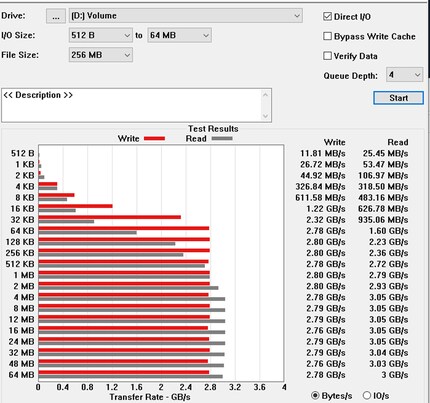
Once I have activated the momentum cache function, the P5 reaches up to 10.75 GB/s. With a file size of 64 MB, that's 6.44 GB/s for reading and 6.64 GB/s for writing. More than twice as much as with the momentum cache function deactivated.
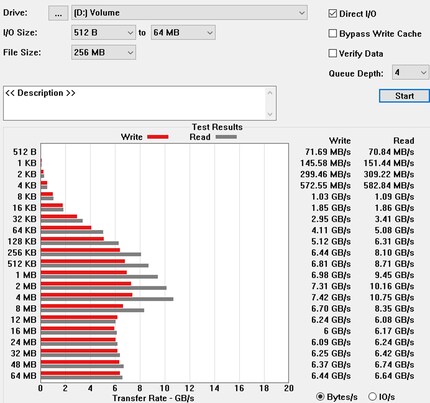
Anvil Storage Utilities
In the Anvil Storage Utilities benchmark, the P5 is ahead of the SN750 in terms of read performance due to the shorter response times and the P5 is also ahead in terms of IOPS. The opposite is true for writing, where the SN750 is ahead due to the shorter response times and more IOPS. In the overall score, the P5 only has an advantage of 0.8 per cent.

With the Momentum Cache function activated, there is almost 63 per cent more performance. The function is particularly helpful for write tests.
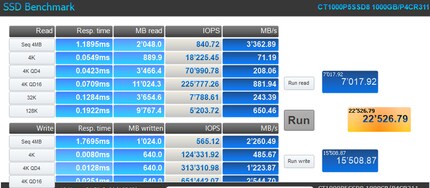
PCMark 8
The P5 is also faster in PCMark 8. Here too, the difference is minimal at just under one per cent. As PCMark 8 lasts around an hour and the SSD is always active during this time, this benchmark is the best way to make a statement about the temperature. The P5 reaches a maximum temperature of 65° Celsius. That is almost 20° Celsius more than the SN750 tested. However, this result is not comparable, as I tested the P5 on the open Tes-Bench and the results of the SN750 come from a test in a PC case. There I have a constant airflow with the case fans, which is missing on the test bench. Therefore, the temperature differences are normal and lower temperatures of the P5 can be expected in a case.

Load times for games
In the benchmarks, the difference between the SSDs is not great. This changes with the loading times of the games. Here, the P5 leaves the SN750 far behind in two games.

So that I still have a comparison with the momentum cache function activated, I load my savegame in "Final Fantasy XV" again with this function. The difference here is significantly smaller than with the ATTO Disk Benchmark and Anvil's Storage Utilities. The game loads in 11.29 seconds. The lower difference in loading time is probably due to the fact that the momentum cache function makes use of the DRAM, which is already under more load when the game is running than in the benchmark.
When it comes to installing "CS: GO", the SN750 has the edge again. It only needs 48 seconds - in contrast to the P5's 84 seconds. Does the P5 throttle the speed once a certain amount of data has been transferred? To find out, I copy two uncompressed films, which together are 69 GB in size, from the P5 to the P5. I do the same on the SN750 and the SSD from WD is a lot faster during the copying process: the films are copied in one minute at an average of 1.1 GB/s. The P5 takes 36 seconds longer. The P5 takes 36 seconds longer. It starts with around 1.1 GB/s, but after around 7 GB it throttles the average speed to 800 MB/s. After around 60 GB of copied data, the speed drops to around 500 MB/s.
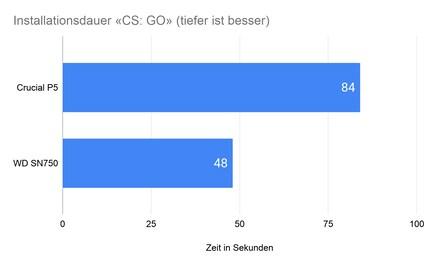
Conclusion: Particularly interesting for gamers
In the synthetic benchmarks, the P5 doesn't differ much from the competition from Western Digital. At least as long as the Momentum Cache function is deactivated. As soon as you enable it, the P5 pulverises the SN750 in the ATTO Disk Benchmark and Anvil's Storage Utilities.
The P5 is particularly impressive when it comes to game loading times. Here it is up to twice as fast as the SN750, which makes a difference in games with long loading times such as "Final Fantasy XV". However, the SSD slows down when writing large amounts of data. This can be seen not only when installing "CS: GO", but also when copying the two films.
The SSD is therefore particularly suitable for gamers who want fast loading times and employees who work with smaller amounts of data, under 10 GB. With a launch price of 211 francs, the SSD is priced in line with the SN750, which costs 206 francs. Crucial's advantage: the company offers full speed from a capacity of 500 GB. With competitors WD and Samsung, this is only the case from 1 TB. If 500 GB of storage capacity is enough for you, the P5 is a good deal.
From big data to big brother, Cyborgs to Sci-Fi. All aspects of technology and society fascinate me.


